Ijraset Journal For Research in Applied Science and Engineering Technology
- Home / Ijraset
- On This Page
- Abstract
- Introduction
- Conclusion
- References
- Copyright
IOT Based Fuel Theft Monitoring System
Authors: Prof. Anil Kadu, Aaryen Patil, Aditya Patil, Ritiksha Pardhi, Bhavesh Patil
DOI Link: https://doi.org/10.22214/ijraset.2023.56671
Certificate: View Certificate
Abstract
This research paper mainly focuses on development of a \"Fuel Theft Monitoring System \" which addresses the pressing issue of fuel theft, which poses significant financial losses and operational disruptions for vehicle owners and fleet managers. This project aims to develop an innovative solution that accurately measures the quantity of fuel poured into a tank and sends real-time message alerts in case of fuel theft events. The system incorporates sensor-based technology and a secure communication system to ensure precise monitoring and timely alerts. The project\'s results demonstrate accurate fuel measurement, effective detection of theft incidents and compatibility with various fuel tanks. The system\'s cost-effectiveness and potential integration with existing tracking systems contribute to its accessibility and usability for a wide range of users.
Introduction
I. INTRODUCTION
Fuel theft and unauthorized usage have grown to be major issues for both individuals and organizations in the modern world, when energy resources are essential for running businesses, transit systems, and daily living. In addition to causing large financial losses, fuel theft also presents serious concerns to the environment and public safety. Innovative technical solutions are necessary to detect and successfully stop fuel theft in order to tackle this growing issue.
The creation and implementation of a complex and reliable system named as Fuel Theft Monitoring System (FTMS), was created to solve the problems caused by fuel theft.
The FTMS seeks to protect energy resources, reduce financial losses, and develop sustainable fuel management practices through data processing and real-time monitoring.
This study examines the complex technological elements of the FTMS and sheds insight on the sensor technologies and data processing methods used to identify fuel theft.
The study also looks at how the FTMS can be seamlessly integrated with current gasoline storage tanks, enabling a comprehensive and simplified approach to fuel monitoring and theft prevention.
The results of this research project have the potential to greatly expand the body of information already available. The research not only gives organizations a useful tool to fight fuel theft, but it also offers comprehensive insights into the design, implementation, and implications of the Fuel Theft Monitoring System, giving policymakers and legislators the knowledge they need to create successful strategies, policies, and regulations. Ultimately, the study hopes to reduce the broad effects of fuel theft by fostering a more safe and sustainable energy ecosystem.
II. LITERATURE REVIEW
Here are some papers surveyed for literature review purposes.
- "Automatic Fuel Tank Monitoring and Leakage Detection" by Shubham Kamthe, Komal Bodkhe, Mihir Karnavat, Bilal Shaikh, and Prof. S.S Pawar
It was published in the IRJET publication, it presents an automated system for monitoring the fuel level in a tank and detecting leaks.The proposed system uses a microcontroller-based circuit and ultrasonic sensors to continuously monitor the fuel level in the tank. The data is then transmitted to a computer for real-time monitoring and analysis. In addition, the system is equipped with a gas sensor to detect any potential fuel leaks.
The paper describes the design and development of the system, including the circuit diagram and programming code. The authors conducted several experiments to test the accuracy and reliability of the system, and the results demonstrate its effectiveness in detecting fuel level and leakage.
Overall, the proposed system can help prevent fuel waste and reduce the risk of environmental contamination caused by fuel leakage.[1]
2. “GSM Based Fuel Theft Detection” by Manoj Saini , Shagufta Khan .
This research is designed to evaluate how well GSM-based technology works when delivering SMS to consumers via an exterior physical connection method. The combination system created for GSM is used by the Anti-Theft Safety System to track and safeguard the car. In the event of gasoline theft, the system notifies the proprietor of the car and activates the alert built into the system using the buzzer.Fuel security is of utmost significance to the community, and as a result, the document was acknowledged due to the alarming number of fuel theft cases present in our nation. By using this car, you can secure yourself no matter where you store it, as long as the GSM network is covered. This paper's goals are to: a) Use an infrared sensor to measure gasoline loss and level. b) Check the gasoline supply for long-distance driving. c) Obtain the car owner's SMS sensing information and use the GSM module to report the crime. [2]
3. “Vehicle Fuel Level Monitor and Locate the nearest petrol pumps using Iot” by Sandhya rani , Sai Krishna Katti , Amrutha Ananthula , Dr.N.Venu .
In this project, gasoline-related IoT and mobile activities, such as real-time fuel monitoring and GPS tracking, are designed and developed. The suggested IoT gadget employs an ultrasonic gasoline gauge to detect the fuel level. When the gasoline level in the car tank hits a certain level, the driver receives a notice via a mobile application and looks up the closest fueling station. The suggested method used GPS tracking to display the vehicle's present position and locate the closest gas station. Unlike a current fuel level monitoring system. It varies by keeping track of the fuel level and giving users access to track the car from anywhere using IoT. Automatically refreshes the data on the arrival of fuel inside the tank. In order to avoid fuel theft, this device's primary function is to identify and monitor the gas stations nearby. [3]
4. “Avoiding fuel theft in multifleet vehicles using vehicular adhoc network” by P. Senthilraja & B. G. Geetha
In this project, the authors have used vehicle-to-vehicle (V2V) and vehicle roadside wireless communication network which is vehicular ad-hoc network (VANET) which is a unique mobile ad-hoc network. VANET is an independent network which can organize by itself as both servers and clients for exchanging and sharing information. In a multi-fleet system, this acts as a mode of internal communication in sharing information between themselves. This work involves proposals for multi-fleet vehicles using VANET for integrating Wireless Sensor Networks. This is particularly used in sensors that are utilized in determining the fuel pilfering with the other vehicles. Due to frequent change in location and separation, it is hard to plan an effective routing protocol to route data between vehicles which is otherwise called V2V communication and Vehicle to roadside Infrastructure. A delay tolerant network based clustering is used in enhancing the quality of service for effective communication between vehicles. Ant colony optimization (ACO)-GeoSpray routing is used to route between vehicles. Through ACO, the best multi hop routes are selected. The outcome of the study showed that a better performance was achieved through the proposed technique.
5. “Designing Security Intelligent Agent for Petrol Theft Prevention” by Mahmoud Bakkar, Ammar Alazab
The demand for gasoline facilities has grown as a result of the exponential growth of the automotive industry and the rise in city traffic. Because of the rising demand, there are more theft incidents at the gas stations, especially when customers fill up their vehicles without paying. However, there are a number of anti-petroleum theft efforts that make use of closed-circuit television cameras (CCTV) to identify features or licence plates on vehicles. The evidence, however, indicates that current methods for identifying fuel theft are less useless and time-consuming because it has taken longer to identify the perpetrators and because it is not a good measure to discourage criminals because it is insufficient to be exact on evidence/mapping characteristics.
The tracking of mobile devices used to stop gasoline theft is addressed in this report by Media Access Control (MAC). In order to create a framework that can both avoid and identify fuel theft, Mac addresses are extracted from client mobile devices. To create this structure, the car registration number is also recorded.
III. METHODOLOGY / EXPERIMENTAL
A. Methodology
- Research and Requirement Analysis: Comprehensive research into contemporary fuel monitoring systems encompasses evaluating theft detection methods and communication protocols. By engaging stakeholders, we can ascertain their precise needs and expectations, thereby informing the development of an optimal solution that addresses monitoring accuracy, theft prevention, and efficient data transmission in the fuel management domain.
- Hardware and Sensor Selection: In selecting hardware components and sensors for precise fuel quantity measurement, various factors like compatibility, precision, durability, and cost-effectiveness must be weighed. Promising choices may include ultrasonic level sensors, capacitive fuel level sensors, or flow meters, which align with accuracy requirements. Evaluating these options and their technical specifications in relation to the application context will facilitate an informed decision-making process.
- Device Design and Development: The Fuel Theft Monitoring Device integrates chosen hardware components, such as ultrasonic level sensors for accurate fuel measurement, with communication modules like GSM or IoT technology. This cohesive design ensures real-time fuel level monitoring and theft detection, enhancing overall fuel management efficiency.
- Communication System Implementation: Develop a robust communication system utilizing protocols and APIs like HTTP or SMPP for seamless integration with SMS gateways. This enables the Fuel Theft Monitoring Device to send immediate, real-time SMS alerts, ensuring timely notification of any suspicious activities or fuel level anomalies.
B. Hardware & System Prototype
- HC-SR04 Ultrasonic Sensor: With an operational range of 2 cm to 400 cm (about an inch to 13 feet), the HC-SR04 is an affordable and straightforward distance measurement sensor. The ultrasonic it emits at 40 000 Hz will not pass through it.To the module it will return. Distance is calculated while taking into account the sound's speed and travel time.
- YFS2O1: Flowmeter: A pinwheel sensor in the Water Flow Sensor YF-S201 1/2 inch measures how much water has passed through it. It is placed within the line along with the water flow. With each rotation, an embedded magnetic Hall-Effect sensor produces an electrical pulse. The YFS201 hall effect water flow sensor may be readily interfaced with any microcontroller and Arduino board because it just has three wires. It works on 5V supply and gives pulse output, the sensor needs to be tightly fitted between water pipelines. A hall effect sensor is built into this sensor, which is positioned in line with the water line, and it measures how much liquid has passed through it. With each rotation, an embedded magnetic hall effect sensor produces an electrical pulse. The hall effect sensor can remain secure and dry because it is isolated from the pipe's fuel flow.
- Active Buzzer (5V): It is an active buzzer, which essentially implies that even when supplied with constant DC power, it will hum at a predetermined frequency (2300–300 Hz) on its own.
- Arduino UNO: The ATmega328P serves as the central component of the Arduino UNO microcontroller board. It offers six analog inputs that can function as PWM outputs, and it incorporates a 16 MHz ceramic resonator. The board is equipped with 14 digital input/output pins, a USB connector, a power jack, an ICSP header, and a reset button. It includes all the necessary components to support the microcontroller, requiring only the insertion of a USB cable, an AC-to-DC converter, or a battery to start using it.
- ESP32 SIM800C: The ESP32 SIM800C microcontroller is a powerful device that combines the capabilities of the ESP32, a popular Wi-Fi and Bluetooth-enabled microcontroller, with the SIM800C module, which provides GSM/GPRS communication functionality. This combination allows for both wireless internet connectivity and cellular communication capabilities in a single compact module.
C. Circuit Diagram
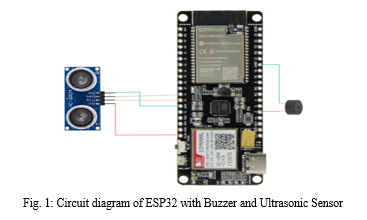
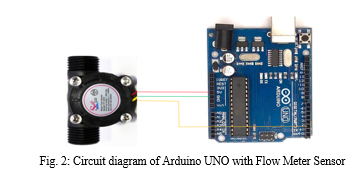
D. Working of the System
- Fuel Measurement: The system utilizes a Flowmeter sensor which is installed on the fuel tank to measure the quantity of fuel being poured. The sensor accurately detects and records the fuel level in real-time.
- Data Processing and Analysis: The recorded fuel level data is processed and analyzed. Analysis of fuel consumption patterns is done and it is compared against predefined thresholds to detect any unusual changes or discrepancies.
- Theft Detection: Based on the analysis, if a significant and unexpected fuel level drop is detected, indicating a potential fuel theft event, the system identifies it as a theft alert, and the active buzzer will go off.
- Communication System: The system utilizes a secure communication system, either through an integrated SIM card or a connected mobile device, to send the alerts to designated recipients, such as vehicle owners or fleet managers.
- Monitoring: The System’s monitored values are displayed on BLYNK which is a web-based platform. Users can monitor fuel levels and provide real-time visibility of fuel in the vehicle.
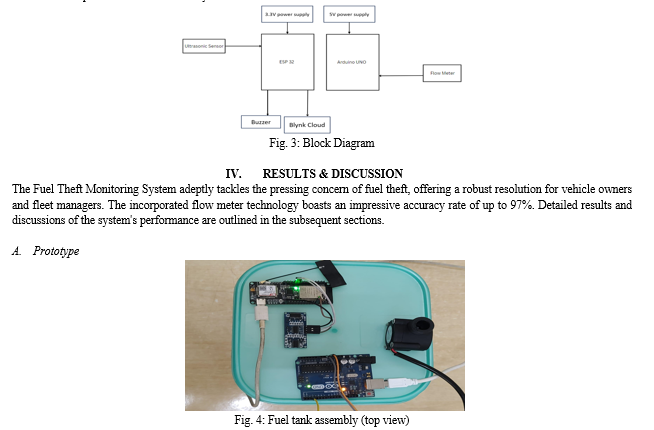
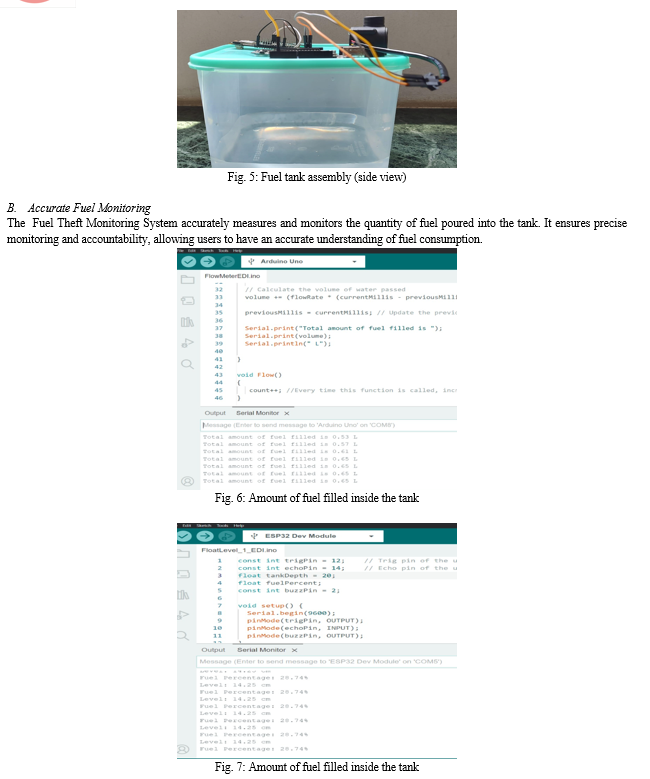
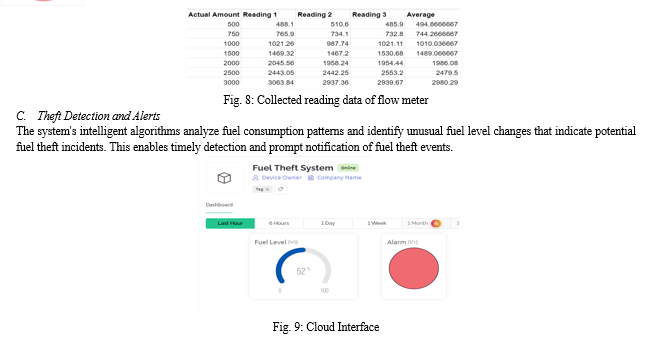
V. FUTURE SCOPE
Integration with GPS Tracking: Integrating the Fuel Theft Alert Device with GPS tracking systems would provide real-time location data, allowing for more precise and immediate response in the event of fuel theft.
Expansion to IoT Ecosystem: Will enable seamless connectivity with other devices and systems, such as fuel pumps and security cameras. This integration would create a comprehensive and interconnected fuel theft prevention system, further enhancing monitoring and response capabilities.
Conclusion
To sum up, the Fuel Theft Monitoring System is an essential and proactive tactic in the fight against the growing threat of fuel theft. Businesses and people may successfully protect their priceless fuel supplies, reduce financial losses, and promote sustainable fuel management practices by putting this strategy into practice. The importance of the FTMS and its cutting-edge technological capabilities have the ability to bring about a fundamental paradigm change in fuel security.
References
[1] Shubham Kamthe, Komal Bodkhe, Mihir Karnavat, Bilal Shaikh, Prof S.S Pawar, “Automatic Fuel Tank Monitoring and Leakage Detection ”, International Research Journal of Engineering and Technology (IRJET), Volume: 07 Issue: 05 | May 2020, e-ISSN: 2395-0056 [2] Manoj Saini , Shagufta Khan, “GSM Based Fuel Theft Detection”, 2021 1st International Conference on Power Electronics and Energy (ICPEE), Date Added to IEEE Xplore: 26 February2021,DOI:10.1109/ICPEE50452.2021.9358644 [3] Sandhya rani , Sai Krishna Katti , Amrutha Ananthula , Dr.N.Venu “Vehicle Fuel Level Monitor and Locate the nearest petrol pumps using iot”, International Journal from Innovative Engineering and Management Research (IJIEMR) 2022, Published on : 9 Dec 2022 [4] Mahmoud Bakkar, Ammar Alazab ,“Designing Security Intelligent Agent for Petrol Theft Prevention”, 2019 Cybersecurity and Cyberforensics Conference (CCC), Date Added to IEEE Xplore: 03 October 2019, DOI: 10.1109/CCC.2019.00006 [5] P. Senthilraja, B. G. Geetha, “Avoiding fuel theft in multifleet vehicles using vehicular adhoc network”, Cluster Comput 22 (Suppl 5), 11175–11181(2019), Published 23 November 2017, DOI : 10.1007/s10586-017-1347-9 [6] Vinod Patil, Nandini Hiremath , Mrunali Kumbhar1 , Aakriti Singh Pathania “Smart Fuel Theft Detection using Microcontroller ARM7”, Published in International Journal of Engineering Research & Technology (IJERT), ISSN:2278-0181 IJERTV4IS090155 www.ijert.org , Vol. 4 Issue 09, September-2015 [7] Rubayat Islama , Muntasir Alama , Irfan Ahmeda and A.K. Azadb, “Automatic prevention model for vehicle fuel theft”, 6th BSME International Conference on Thermal Engineering (ICTE 2014) [8] Sanketh B Prabhu; K Deepa; M. Nithya “IoT Enabled Fuel Level Monitoring and Automatic Fuel Theft Detection System”, 2022 13th International Conference on Computing Communication and Networking Technologies (ICCCNT,DOI:10.1109/ICCCNT54827.2022.9984515
Copyright
Copyright © 2023 Prof. Anil Kadu, Aaryen Patil, Aditya Patil, Ritiksha Pardhi, Bhavesh Patil. This is an open access article distributed under the Creative Commons Attribution License, which permits unrestricted use, distribution, and reproduction in any medium, provided the original work is properly cited.

Download Paper
Paper Id : IJRASET56671
Publish Date : 2023-11-15
ISSN : 2321-9653
Publisher Name : IJRASET
DOI Link : Click Here
 Submit Paper Online
Submit Paper Online

